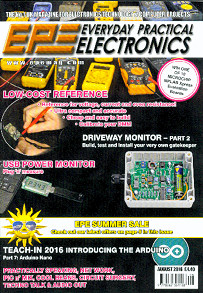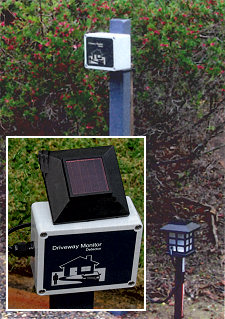August 2016
This month’s highlights
Low-Cost Voltage, Current and Resistance Reference
This tiny module uses a 3V lithium coin cell, a voltage reference i.c., a precision resistor and little else! It provides a :
- Reference voltage of 12.5V ±1mV (±0.04%).
- Resistance of 1k ±1Ω (±0.1%)
- Current of 2.5mA ±3.5µA (± 0.14%)
It can be used for checking or calibrating multimeters or anywhere that an accurate and stable voltage is required. Its low power design has an auto-off function, power LED and its battery is good for over ten years with intermittent use.
![]() Surface mount design needs good soldering skills
Surface mount design needs good soldering skills
Special feature: checking and calibrating multimeters
Multimeters tend to drift off calibration quite markedly as the years pass by. So how old is your multimeter and has it ever been checked? This special feature explains how to use our Low-Cost Voltage, Current and Resistance Reference project to bring your multimeter back up to scratch.
USB Power Monitor
This LCD module measures current, voltage and power of a USB port, by connecting in between the USB port and the connected USB load. The auto-ranging design measures from a few microamps up to over an amp, and displays power from milliwatts to watts.
Includes display flip mode, mode memory and digital calibration. PIC 18F45K80 based, requires source code (hex file) available as a free download from our Online Shop as usual.
![]() Surface mount design needs good soldering skills
Surface mount design needs good soldering skills
Driveway Monitor – Part 2
Last month we introduced our new Driveway Monitor and described how it worked. In Part 2 this month, construction, testing and installation are described. Various options are also outlined, so you can build it to operate just the way you want, and the solar charger aspect is explained as well.
Teach-In 2016 Part 7: Arduino Nano
If you’d like to get up to speed with Arduinos then our latest Teach-In series is just for you. In Part 7 this month, the Arduino Nano (picture, right) is explored. This diminutive device offers a highly cost-effective alternative to the Uno (picture, left) that’s compact enough to tuck away into the smallest of spaces. This month’s Arduino Workshop suggests a passive infra-red (PIR) motion sensor, and Coding Quickstart looks at tone generation. An Arduino Nano-based PIR motion alarm is described as our Get Real project.
PIC n’ MIX
PIC and the PICkit 3: A beginner’s guide (Part 3)
In Parts 1 and 2 in previous months the basic concepts of PIC circuit development were covered, from MCUs and MPUs, to programmers, compilers and IDEs. Part 3 continues with an exploration of Microchip’s MPLAB X IDE. It’s an excellent introduction to using PIC microcontrollers with today’s modern tools, not to be missed!
Net Work 20th Anniversary
Celebrating 20 years of writing our Net Work – the Internet column, Alan Winstanley recounts the history of the Internet, how it all started and how EPE embraced the web twenty years ago. First in a two-part special article.
^ Brother EP-44 Mobile Email solution, 1986
Cold War Computing/ SAGE USAF Video
SAGE Youtube Video (correct URL)
^ A SAGE (Semi-Automatic Ground Environment) operator checks a scope reading with a light-gun. Still from the USAF movie
![]() A PDF of the author’s original 1996 article (The ‘Net – What’s in it for you?’ , from which Net Work was originally created, is downloadable from EPEMag.Net
A PDF of the author’s original 1996 article (The ‘Net – What’s in it for you?’ , from which Net Work was originally created, is downloadable from EPEMag.Net
Also in this month’s issue:
- Techno Talk – radio ‘astrology’ is not nonsense!
- Interface – Capacitance Meter Mk 2
- Circuit Surgery – the mechanics of using ammeters and voltmeters
- Audio Out – super simple retro amp-speaker combo (Part 2)
- Max’s Cool Beans – diorama effects controlled by an Arduino
Next month
Compact, hybrid switched mode 100W Bench Supply (Part 1); Speedo Corrector; LED Party Strobe; Teach- In 2016 (Part 8) – infra red controllers using Arduino
This month’s highlights
Low-Cost Voltage, Current and Resistance Reference
This tiny module uses a 3V lithium coin cell, a voltage reference i.c., a precision resistor and little else! It provides a :
- Reference voltage of 12.5V ±1mV (±0.04%).
- Resistance of 1k ±1Ω (±0.1%)
- Current of 2.5mA ±3.5µA (± 0.14%)
It can be used for checking or calibrating multimeters or anywhere that an accurate and stable voltage is required. It’s low power design has an auto-off function, power LED and its battery is good for over ten years with intermittent use.
![]() Surface mount design needs good soldering skills
Surface mount design needs good soldering skills
Special feature: checking and calibrating multimeters
Multimeters tend to drift off calibration quite markedly as the years pass by. So how old is your multimeter and has it ever been checked? This special feature explains how to use our Low-Cost Voltage, Current and Resistance Reference project to bring your multimeter back up to scratch.
USB Power Monitor
This LCD module measures current, voltage and power of a USB port, by connecting in between the USB port and the connected USB load. The auto-ranging design measures from a few microamps up to over an amp, and displays power from milliwatts to watts.
Includes display flip mode, mode memory and digital calibration. PIC 18F45K80 based, requires source code (hex file) available free from our Library as usual.
![]() Surface mount design needs good soldering skills
Surface mount design needs good soldering skills
Driveway Monitor – Part 2
Last month we introduced our new Driveway Monitor and described how it worked. In Part 2 this month, construction, testing and installation are described. Various options are also outlined, so you can build it to operate just the way you want, and the solar charger aspect is explained as well.
Teach-In 2016 Part 7: Arduino Nano
If you’d like to get up to speed with Arduinos then our latest Teach-In series is just for you. In Part 7 this month, the Arduino Nano (picture, right) is explored. This diminutive device offers a highly cost-effective alternative to the Uno (picture, left) that’s compact enough to tuck away into the smallest of spaces. This month’s Arduino Workshop suggests a passive infra-red (PIR) motion sensor, and Coding Quickstart looks at tone generation. An Arduino Nano-based PIR motion alarm is described as our Get Real project.
PIC n’ MIX
PIC and the PICkit 3: A beginner’s guide (Part 3)
In Parts 1 and 2 in previous months the basic concepts of PIC circuit development were covered, from MCUs and MPUs, to programmers, compilers and IDEs. Part 3 continues with an exploration of Microchip’s MPLAB X IDE. It’s an excellent introduction to using PIC microcontrollers with today’s modern tools, not to be missed!
Net Work 20th Anniversary
Celebrating 20 years of writing our Net Work – the Internet column, Alan Winstanley recounts the history of the Internet, how it all started and how EPE embraced the web twenty years ago. First in a two-part special article.
^ Brother EP-44 Mobile Email solution, 1986
Cold War Computing/ SAGE USAF Video
SAGE Youtube Video (correct URL)
^ A SAGE (Semi-Automatic Ground Environment) operator checks a scope reading with a light-gun. Still from the USAF movie
![]() A PDF of the author’s original 1996 article (The ‘Net – What’s in it for you?’ , from which Net Work was originally created, is downloadable from EPEMag.Net
A PDF of the author’s original 1996 article (The ‘Net – What’s in it for you?’ , from which Net Work was originally created, is downloadable from EPEMag.Net
Also in this month’s issue:
- Techno Talk – radio ‘astrology’ is not nonsense!
- Interface – Capacitance Meter Mk 2
- Circuit Surgery – the mechanics of using ammeters and voltmeters
- Audio Out – super simple retro amp-speaker combo (Part 2)
- Max’s Cool Beans – diorama effects controlled by an Arduino
Next month
Compact, hybrid switched mode 100W Bench Supply (Part 1); Speedo Corrector; LED Party Strobe; Teach- In 2016 (Part 8) – infra red controllers using Arduino

Printed Circuit Boards
We supply PCBs for all our projects going back to 2013.
New PE service – Programmed PICs
Buy programmed PICs for most of our projects.








